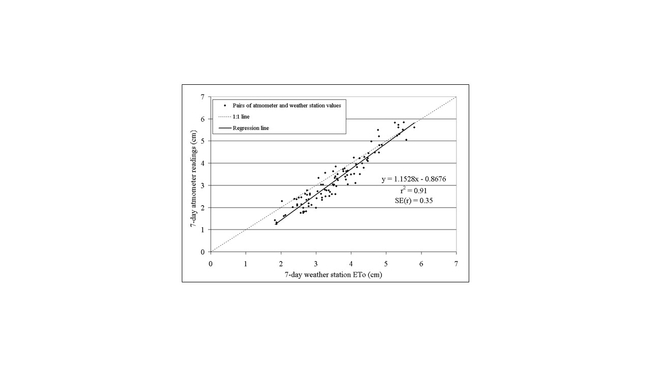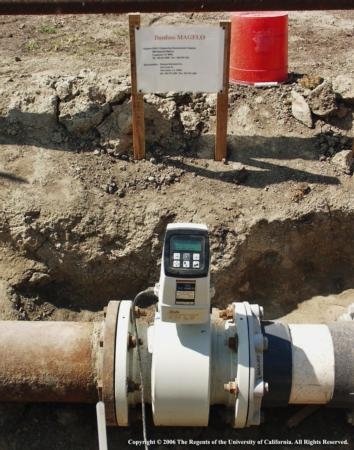
Posts Tagged: irrigation scheduling
Irrigating with an Atmometer?
Say what? Atmosphere meters can be used to assess irrigation requirement. Here's a great little report from Mark Battany, our advisor in Santa Barbara and San Luis Obispo Counties.
ATMOMETERS FOR IRRIGATION MANAGEMENT
- Author: Mark Battany
Efficient and precise irrigation management is becoming increasingly important inCaliforniaagriculture, both for maximizing crop quality and for conserving water. The most advanced irrigation scheduling strategy is based on local measurements of reference evapotranspiration (ETo), which is converted to crop evapotranspiration (ETc) with an appropriate crop coefficient (kc).
To be able to use this method, an irrigation manager needs to have locally accurate ETo values throughout the growing season. However, the highly variable microclimates that characterize many farming areas often make it difficult to use data from distant weather stations; therefore an accurate local measurement may often be preferable to relying on a regional value.
One inexpensive option for measuring ETo locally is to use a simple atmometer. Atmometers are water-filled devices, in which the actual evaporation of water is measured over time. In their simplest form, the atmometer is outfitted with a graduated sight glass on the water supply tank which allows the user to easily measure the evaporation that occurred over a given period. In practice, this type of atmometer is most suited for making readings at multiple day intervals, for example once per week, or on days when irrigation is applied.
The performance of atmometers versus more expensive weather stations was evaluated on the CentralCoastin 2003. In this study, atmometers were placed adjacent to seven weather stations throughout the area, and weekly values for both methods were compared. The results indicate that the atmometers and weather stations have very comparable ETo readings, with the atmometers indicating somewhat lower ETo values under conditions of lower evapotranspiration.
Like any technique, using atmometers has advantages and disadvantages. Advantages include their very low cost and ease of operation, with no computer or power required. Disadvantages include the potential for damage by freezing weather, the need to refill the water supply (every three to six weeks), and the need to read the gauge manually. Also, if they are installed in a large open area, birds may tend to perch on the evaporating surface and foul it with their droppings; for this reason several wires are installed on top of the device to discourage birds from perching there. In general, atmometers function quite reliably with few problems.
Converting atmometer ETo readings to the amount of irrigation run time required to replenish the soil moisture lost to evapotranspiration is fairly straightforward. A relatively simple example for a sprinkler-irrigated field is presented below in Table 1.
|
Table 1. Example conversion of ETo to irrigation run times for a sprinkler irrigated field |
||
|
|
|
|
|
A. Measured atmometer ETo for one week |
2 |
inches |
|
B. Crop coefficient (kc) |
0.8 |
|
|
C. Calculated ETc for the week (=AxB) |
1.6 |
inches |
|
D. Sprinkler application rate |
0.13 |
in/hr |
|
E. Hours of irrigation required (=C/D) |
12.3 |
hours |
(Note: To convert Gallons to Inches: Gallons ÷ Area (square feet) ÷ 0.6234 = Inches. To convert Inches to Gallons: Inches * Area (square feet) ÷ 1.604 = Gallons)
Regression table showing relationshiop between CIMIS weather station and atmometer
Atmometer in the field

atmometer grapes
Soil Moisture Sensor Selection is Confusing
So, every few weeks the question comes up of whether to install soil moisture meters which leads to the question of which to buy and install or have installed. And then come the questions of what do the readings mean and why aren't the readings consistent. Or maybe this question arrives after the grower has installed the sensors or system and the values don't conform to a known or knowable pattern.
The first question to the grower is why they want to install soil moisture sensors or a system. Everyone has a different answer which I've always found interesting. Usually it boils down to having more or better information, although it's hard to beat a good old soil auger. Which takes time and labor.
So once that is cleared up, it comes down to what area they want to monitor. Is it an acre, 10 acres, 50 acres, 100 acres, 200 acres, 1,000 etc.? What are the different irrigation blocks, soil types, aspects? How complex is the area that is to be monitored? Do they need one monitoring site or many? Can the information be gathered in the field, or does it need to be accessed from a distance? Linked by hardwire, infrared, cell phone, wifi, satellite, etc.?
Then the question is does the grower do the installation or is it done by a company? And then whatever the case is, who maintains the system and for that matter, who maintains the information? What software is used and who interprets it?
And what sensors are being used: tension, electrical resistance, conductance, capacitance, electromagnetic…….? The list seems to go on and there are no models and brands coming out on a regular basis. And how reliable are the sensors? What's their lifespan? And what are they measuring and in what units? How affected are the readings by salinity and what soil volume are they measuring? And how important is their placement?
This last point is so often overlooked. The sensor needs to be in the active root zone where water is being taken up. Not where it's convenient to read, not where the plants cant use the water. Placement is so often overlooked.
And then how much do you want to spend? $100 per installation, $1000? With a monthly or yearly maintenance fee or none? Who responds when there are problems?
Wow, so yeah, there are lots of questions. Here's a chart that might help categorize some of the questions:
|
Method |
Cost |
Ease of use |
Accuracy |
Reliability |
Salt-affected |
Stationary |
|
Gypsum block |
L |
H |
H |
H |
L |
YES |
|
Tensiometer |
L |
M |
H |
M |
L |
YES |
|
Portable tensiometer |
M |
M |
H |
M |
L |
NO |
|
Solid-state tensiometer |
M |
H |
H |
H |
L |
YES |
|
Time domain reflectometer |
H |
M |
H |
H |
M |
BOTH |
|
Neutron probe |
H |
L |
H |
H |
L |
YES |
|
Feel (soil probe) |
L |
H |
H |
H |
L |
NO |
|
Gravimetric (oven) |
L |
M |
H |
H |
L |
NO |
|
Conductance |
L |
H |
M |
M |
H |
BOTH |
|
Capacitance |
M |
H |
M |
H |
M |
BOTH |
H, high; M, medium; L, low
And the good Almond Doctor might help some more:
http://thealmonddoctor.com/2015/07/10/soil-moisture-sensing-systems/
And maybe some of these publications can help sort out what questions to ask
http://calag.ucanr.edu/Archive/?article=ca.v054n03p38
http://calag.ucanr.edu/Archive/?article=ca.v054n03p47
http://anrcatalog.ucanr.edu/Details.aspx?itemNo=21635
Khaled Bali, our Irrigation Specialist at Kearney Research and Education Center near Fresno, is part of a group in the process of evaluating different types and models of soil moisture sensors. He should have a publication that can more accurately sort through the many sensor choices that are available at this time. But in time, there should be more models on the market and new update will be necessary.
The question, though, is to ask yourself how irrigation is being done and how it can be improved. The basics of design, maintenance, distribution uniformity and how scheduling is being currently done – when and how much to apply. Definitely, soil moisture sensors can help, but you gotta know how to use them and maintain them, just like the whole irrigation system.
A grower who uses tensiometers told me that people think of soil sensors as though they were reading a book. Something cut and dried. A simple plot line that you follow. Irrigation is not a book. There are many other subplots to irrigation than just reading the digital face. Looking at the weather, evapotranspiration, the tree, how fast the moisture is depleted, how deep the moisture is being pulled from all contribute to the "sensors" used to irrigate. Use them all. Even though this grower has irrigators on 250 acres of trees, he also checks the orchard tensiometers at least once a week on his own to confirm all of his senses.
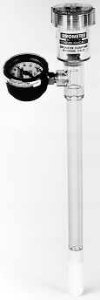
tensiometer2
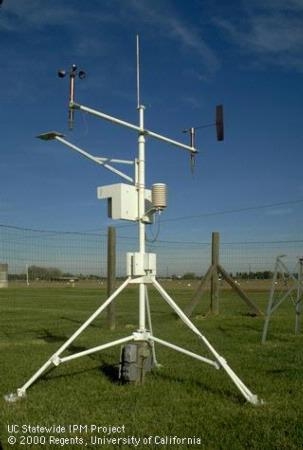
cimis
Flowmeters? You Need One.
At a recent CA Avocado Society meeting there was a discussion about bout flowmeters and their selection. Flowmeters measure the volume of water moving through a full-flowing closed pipe and as such are one of the key components of an irrigation system whether drip, microsprinkler or full pressure systems. They are essential for managing irrigation efficiently and for monitoring the performance of the irrigation system. Managing irrigation efficiently requires: (1) knowing how much water the crop has used since the last irrigation (irrigation schedu7ling); and (2) operating the irrigation system to apply only the amount of water desired. A flowmeter gives the grower the information needed to apply only the amount of water required.
A critically overlooked benefit of a flowmeter is that it makes it possible to identify changes in flowrate during the season (measured at the same pressure), which may indicate problems such as clogging of emitters or filters, leaks in the system or problems with the pump or well.
There are several types of flowmeters and each has their pluses and minuses. Propeller meters are the most commonly used, but can pose two potential difficulties: debris in the water and a small loss of pressure which can be a problem with low flow systems. Alternatives are magnetic meters, ultrasonic, turbine and venture meters. Proper selection is based on pipe size, range of flow and pressure loss. But as with everything it depends on proper installation and maintenance.
Attached is a nice little overview by Larry Schwankl on how to choose a flowmeter for your situation.
flow meters
Soil Based Irrigation Scheduling
. A rule of thumb is that irrigation should be done when about 50% of the water has been depleted from the soil in the plant's root zone. This 50% value, however, allows a buffer of water in the soil in case the weather suddenly turns hot and windy. Sandy soils hold less water than clay soils and must be irrigated more frequently. A common misperception is that it takes more water to grow plants in sandy soil than in clay soil; however, the total amount required for the whole year is the same for both soil types. The amount of sunlight, wind, temperature, and humidity control how much water a plant needs, and the soil is only the reservoir.
Determining water content by soil texture
To check the water content in the soil based on the soil texture, dig 8 to 16 inches down into the soil with a trowel, shovel, or soil tube and feel the soil. At about 50% available water:
- coarse soil appears almost dry and form a ball that does not hold shape
- loamy soil forms a dark ball that is somewhat moldable and can form a weak ribbon when squeezed between the fingers
- clayey soil forms a good, dark ball, makes a ribbon an inch or so long, and slightly sticky
This method, however, gives only an approximate water content; instruments can give more precise readings.
For more information, refer to the USDA guidelines at:
http://www.nrcs.usda.gov/Internet/FSE_DOCUMENTS/nrcs144p2_051845.pdf
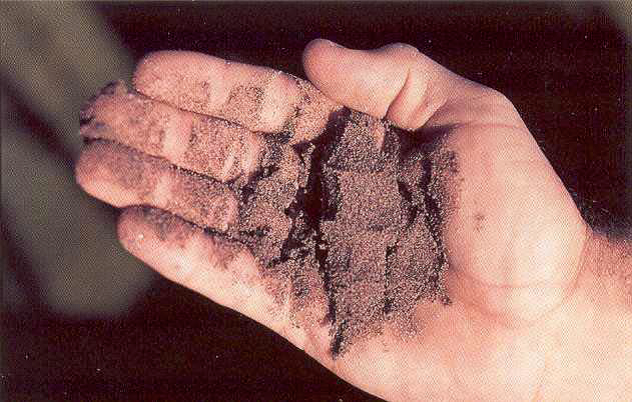
feel method
Do we really need Scientific Irrigation Scheduling?
At first thought this sounds like a dumb question. Of course we need to schedule irrigations … just like we schedule lunch; we get hungry, plants get thirsty. End of story. But how many of you skip lunch, or delay it? How often? If you’re like some of us old agronomists that can’t jump across the head ditch as easily as we used to and you look down and can’t see as much of your feet as you did when you were 25 then you think, “Probably better if I skipped lunch anyway.” Then you think on this idea even more and you say, “Well, I just ain’t gonna eat anything until I see this gut disappear.” But we all know this is bad idea as we still need balanced nutrition regularly even if we do have some extra weight.
So before you think I’m completely out to lunch – here’s the connection: if you don’t irrigate until you see the crop stress you’ve waited too long. If you just keep irrigating every three days with microsprinklers (Hey, that’s a schedule, right!?) from May to August without checking the soil/plant water status it’s like eating that foot long sub sandwich every day for lunch and never stepping on the scale! Neither extreme is healthy for you or the crop.
In many ways the San Joaquin Valley has already been placed on a forced diet. A combination of hydrologic and “judicial” drought (The latter being restrictions of State and Federal Project pumping out of the Delta due to Endangered Species Act listing of the Delta Smelt) has drastically cut the import of fresh water to the SJV over the last 3 to 5 years. Growers and water districts have responded by pumping more groundwater, buying “emergency pool” water and other market trades, improving field irrigation efficiency where possible and finally reducing applied water when they just don’t have enough. Now, more than ever we need to know how to use available information and technology for optimal water use.
|
Process & Planning |
Okay, so I need more than just a calendar to do the best job of irrigation. But what’s this “scientific” thing? Does that mean I have to have a bunch of sensors, loggers and all that stuff? Not at all. In fact, the dictionary meaning of science is NOT ‘using a bunch of gizmos/technology’ but defined as: “systematic knowledge of the physical or material world gained through observation and experimentation.” Wow, sounds pretty close to the definition of a good farmer! Being scientific simply means being consistent in how you record and analyze your observations so that you can develop a system for making the best decisions. This is where gizmos/technology are helpful, as they are tools to collect and analyze data/observations. Some of the most useful gizmos are strictly mechanical.
You can actually do scientific scheduling with no electronics at all; just your hands, a soil probe/auger, regular walks through the field, a notebook and a flometer or weir to record your actual applied water. This was all we had 40 years ago. You don’t even need a computer in the office! But most of us are farming too much acreage to know each field this intimately and we get tired of pounding/twisting soil probes and augers down to 5 feet.
This is where electronic sensors, loggers and automated computer programs are helpful. These devices will automatically collect the data and can do the number crunching that saves you a lot of hand calculation. The only problem is that they’re dumb. They don’t think, they’re usually stuck in one location without the ability to “look around” at the rest of the block. Thus, it’s possible to do “technified” irrigation scheduling (this is the term they like in South America) with all this technology without it being truly “scientific”. In other words, you can collect a whole bunch of numbers but it’s still up to the grower/manager to take those numbers and trends and turn it into systematic knowledge for truly optimal scheduling.
Threre are multiple factors that need to be accounted for if you are going for top field performance - water quality, infilitration rate, rooting depth, drainage, etc. This looks complicated, but in reality most of these are fixed at the time you plant the orchard. Once you determine your soil water holding capacity and irrigation system design application rate, these will be fairly constant. Then the only in-season things that may vary and should be monitored are salinity in the rootzone and irrigation water (How good or bad is it?), soil/rootzone water content (How much is available, how fast are the plants using it?), irrigation frequency (How often?) and system uniformity (How even are my pressures, how often to flush hoses?) The salinity/quality factors are usually tested/treated once a year, unless you’re injecting gypsum and/or acid. So once you’ve processed this data and planned the likely field logistics (i.e. vary irrigation hours to match daily/weekly need or vary onset of irrigation to match a set application say over 24 hours) it’s just a matter of matching the volume water balance pieces together so you can …
These data can be put into a table or even one line of an Excel spreadsheet. You wouldn’t think of buying a booster motor for your pump that didn’t have the boiler plate specs on the casing. But after 23 years of tromping the fields of Kern County I am still surprised by the number of growers and fields that don’t have this simple yet critical information ready and easily accessible.
Using this information along with expected “normal year” ET it’s relatively straightforward to construct a simple water balance checkbook like the one below (which will be available at the workshop).
There are plenty of irrigation scheduling aids/programs on-line. A Google search of “free irrigation scheduling programs” returns more than 80,000 hits. The list will make your head hurt – even before you start to use them. Links to a few of these sites that I have looked at and can recommend as completely free and sponsored by worthy organizations are below:
http://www.cimis.water.ca.gov/cimis/infoIrrSoftware.jsp - Concise list of free and pay-for scheduling software. Some tutorials on basic scheduling. State of CA, Sacramento.
http://www.wateright.org/ - Checkbook type schedule, all on-line, mostly crop water demand based on CIMIS weather and standard crop coefficients. Cal State Fresno, CATI.
http://biomet.ucdavis.edu/irrigation_scheduling/bis/BIS.htm - Multi-worksheet Excel file, completely downloadable, soil moisture estimation but no feedback adjustment. Most comprehensive list of crop coefficients. Calculator for estimating daily crop coefficients. Rick Snyder, UC Davis.
http://cesanjoaquin.ucdavis.edu/files/14724.xls - Simple one-page worksheet checkbook for winegrape irrigation scheduling.
http://oiso.bioe.orst.edu/RealtimeIrrigationSchedule/index.aspx - Most complex of the extension type web-based scheduling programs. Has the capacity to create integrated whole ranch schedules. Difficult to use, but with some of the best “feedback” calculations.

tensiometer2

